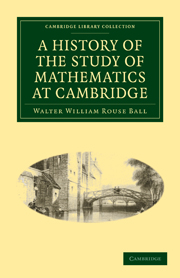Book contents
- Frontmatter
- PREFACE
- Contents
- Chapter I Mediæval mathematics
- Chapter II The mathematics of the renaissance
- Chapter III The commencement of modern mathematics
- Chapter IV The life and works of Newton
- Chapter V The rise of the Newtonian school
- Chapter VI The later Newtonian school
- Chapter VII The analytical school
- Chapter VIII The organization and subjects of education
- Chapter IX The exercises in the schools
- Chapter X The mathematical tripos
- Chapter XI Outlines of the history of the university
- INDEX
Chapter VII - The analytical school
Published online by Cambridge University Press: 07 September 2010
- Frontmatter
- PREFACE
- Contents
- Chapter I Mediæval mathematics
- Chapter II The mathematics of the renaissance
- Chapter III The commencement of modern mathematics
- Chapter IV The life and works of Newton
- Chapter V The rise of the Newtonian school
- Chapter VI The later Newtonian school
- Chapter VII The analytical school
- Chapter VIII The organization and subjects of education
- Chapter IX The exercises in the schools
- Chapter X The mathematical tripos
- Chapter XI Outlines of the history of the university
- INDEX
Summary
The isolation of English mathematicians from their continental contemporaries is the distinctive feature of the history of the latter half of the eighteenth century. Towards the close of that century the more thoughtful members of the university recognized that this was a serious evil, and it would seem that the chief obstacle to the adoption of analytical methods and the notation of the differential calculus arose from the professorial body and the senior members of the senate, who regarded any attempt at innovation as a sin against the memory of Newton.
I propose in this chapter to give a sketch of the rise of the analytical school, and shall briefly mention the chief works of Robert Woodhouse, George Peacock, Charles Babbage, and Sir John Herschel. The later history of that school is too near our own times to render it possible or desirable to discuss it in similar detail: and I shall make no attempt to do so.
The earliest attempt in this country to explain and advocate the notation and methods of the calculus as used on the continent was due to Woodhouse, who stands out as the apostle of the new movement.
Robert Woodhouse was born at Norwich on April 28, 1773, took his B.A. as senior wrangler and first Smith's prizeman in 1795 from Caius College, was elected to a fellowship in due course, and continued to live at Cambridge till his death on Dec. 23, 1827.
- Type
- Chapter
- Information
- A History of the Study of Mathematics at Cambridge , pp. 117 - 137Publisher: Cambridge University PressPrint publication year: 2009First published in: 1889



